Cissus alata
Have you always loved the look of ivy climbing a brick or stone wall?
While most of us can’t recreate that look at home – and probably don’t truly want to, as English ivy can be destructive to even the toughest brick walls – grape ivy (Cissus alata) provides an ideal substitute.
This houseplant shines in a hanging basket or pot with a small trellis attached, so it can show off its slow-growing tendrils.

We link to vendors to help you find relevant products. If you buy from one of our links, we may earn a commission.
Even better, it can live for a decade with the right care. And providing this isn’t hard to do, as it’s an easygoing, low-maintenance plant.
If you want to learn how to grow graceful grape ivy at home, read on!
What You’ll Learn
What Is Grape Ivy?
Grape ivy is native to the tropics of North and South America, from Mexico down through Bolivia.
It’s often grown as a houseplant in the United States, as it wouldn’t thrive outdoors in much of the country, and it makes a spectacular addition to the home.
Also known as “Venezuela treebine,” this tropical vine features dark green, lobed, trifoliolate leaves and a trailing habit. “Trifoliolate” refers to the three separate leaflets that make up each leaf.
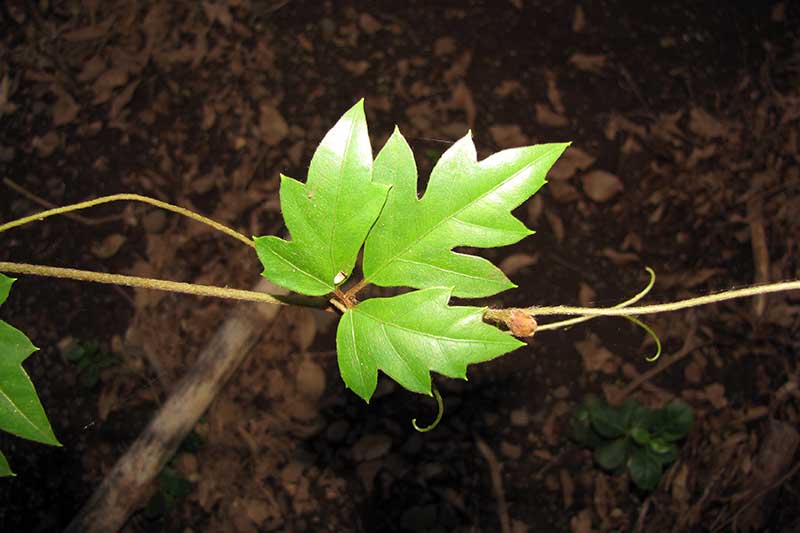
Under the synonym C. rhombifolia, Venezuela treebine won the Royal Horticultural Society Award of Garden Merit in the ornamental plants category in 1993. This species was officially reclassified soon after as C. alata.
The genus Cissus is in the grape family, Vitaceae, and is not a true ivy at all. Grape ivy is related to other vining plants such as the common grape (Vitis vinifera) and Virginia creeper (Parthenocissus quinquefolia).
The name “cissus” comes from the Greek word for ivy, “kissos,” and “alata” is Latin for “winged.” This likely refers to the way each central leaflet is flanked by smaller leaflets that look like wings.
Its former species name, “rhombifolia,” denotes the diamond, or rhombus, shape of the leaves.
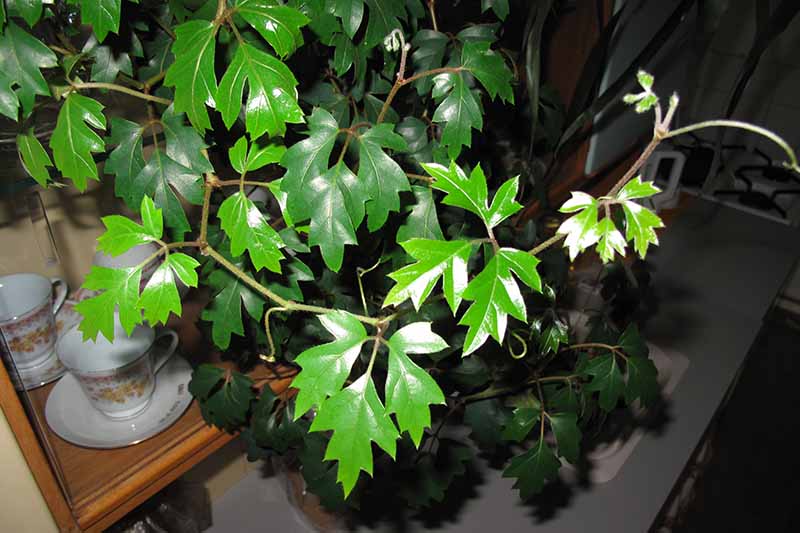
If you were to grow it outside in Zones 10 to 12, grape ivy would produce inconspicuous green flowers and small berries, but this isn’t likely indoors.
C. alata has long been a popular houseplant, though it’s not as common as it used to be in the 1940s. But I think it totally should be, because it’s beautiful and easy to care for.
Even better, it’s a nontoxic, pet-safe houseplant that’s also nontoxic to humans, although the sap can cause a rash in those with sensitive skin. Wearing gloves when handling it is recommended.
Indoors, this plant grows best in temperatures between 65 and 80°F. It can tolerate a wider range of temperatures as low as 35°F and as high as 90°F, although growth will slow down significantly.
C. alata can grow six to 10 feet tall, or long, but indoors it will typically grow two to three feet long. It also gets nice and bushy with a spread of three to six feet outdoors, or one to three feet indoors.
Note that C. alata is not to be confused with Parthenocissus tricuspidata. This plant is also sometimes referred to as grape ivy but is more commonly known as Boston ivy. Boston ivy is in the same family, Vitaceae, but it grows much larger.
C. rotundifolia, a more closely related species, often goes by the name Peruvian grape ivy, or it may be called Venezuelan treebine as well.
Propagation
Since grape ivy doesn’t typically flower when it’s grown indoors, it’s usually propagated not from seed but by rooting cuttings.
To get your hands on a plant, you’ll need to either take and propagate a cutting from a friend’s grape ivy, or purchase a rooted start from a nursery that’s ready for transplanting.
Via Stem Cuttings
The best time to take a stem cutting from a mature outdoor plant is in the spring, when the plant is primed for new growth. But you can technically do it at any time of the year with an indoor plant.
Unless the temperature changes dramatically or you have significantly lower light exposure in the winter (like I do here in Alaska!), your indoor grape ivy will keep growing all year.
Select a six-inch section of vine with at least two or three sets of leaves on it. Use a clean pair of pruners to cut at a 45 degree angle just above a leaf node.
Remove the leaves from the bottom two inches of the vine. Rooting could also be done in soil, but I prefer to fill a clear glass with about three inches of water and set the vine inside.
Place the cup on a table or countertop near a window, as bright, indirect sunlight will help it develop a new root system more quickly. You can lightly mist the leaves every couple of days if you like, to keep the cutting from drying out until roots develop.
Change the water every two or three days to keep it fresh and clear. If the cutting goes limp, starts to rot, or grows mold, toss it and start over.
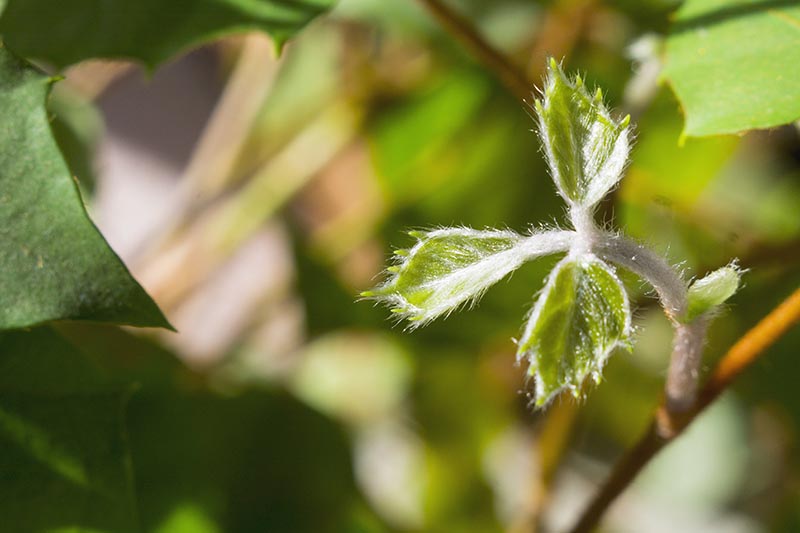
Within two to four weeks, you should see roots growing from the bottom of the cutting. New, fuzzy young leaves will also develop.
Next, choose a pot that’s four to six inches deep and wide. It should also have drainage holes and a detachable dish.
Grape ivy loves quick-draining soil, and a cactus, palm, and citrus mix works well. I like this one from Miracle-Gro that’s available at the Home Depot.
Miracle-Gro Cactus, Palm, and Citrus Potting Mix
You can also put regular potting soil in the container and mix in a small handful of peat or coconut coir to help achieve the ideal soil balance.
Blending a couple tablespoons of extra perlite or bark into each pot will also help with drainage.
Make a hole that’s two inches deep and two inches wide, and set the rooted stem inside. Backfill with soil, but don’t cover more than two inches of the stem – less if you can swing it without your young plant toppling over.
Water your grape ivy baby thoroughly, and then set the pot in an area that receives four to six hours of indirect sunlight through a window each day.
Empty the drainage dish about 10 minutes after watering the plant.
You’ll want to allow the top half inch of potting mix to dry out between waterings when the plant is this young.
After about a year, or whenever the roots begin to poke out of the drainage holes, repot it into a larger container.
Transplanting
Here’s how to repot a plant grown from a cutting, or move a transplant purchased from a nursery into a larger container.
You’ll begin by choosing a container that’s at least 10 inches wide and seven inches deep, to give your Venezuela treebine space to grow.
Grape ivy shines also in a hanging planter, where its tendrils can dangle gracefully over the edge.
Need a recommendation?
This resin hanging container from Arlmont & Co is self-watering, which means the drainage holes empty into an attached dish, and the dish has a drainage plug so you can easily remove any excess water after you hydrate your plants.
Self-Watering Plastic Hanging Planter
Choose from one of four colors, available from Wayfair.
Another fun idea for this houseplant is to use a planter with a trellis attached, like this one from Sol 72 Outdoor that’s available at Wayfair.
You can use this planter indoors and weave the tendrils through the trellis. With just a little bit of help from you at the beginning, the grape ivy will take off and start climbing the trellis on its own!
The inside of this planter is 15 inches tall and 15 inches wide, and the trellis is just under 56 inches tall. You will need to place a drainage dish underneath the planter, as it has holes but no dish.
Whatever type of container you choose, fill it with a quick-draining potting mix. Make a hole that’s as deep and wide as the plant’s root ball.
Carefully ease the existing grape ivy out of its container.
I like to squeeze the sides if it’s in a plastic pot, or use a butter knife to pry the soil away from the edges if I’m working with a terracotta pot or something else that’s inflexible.
Tip the pot onto its side, loosely grasp the foliage, and gently tug the plant out. Don’t yank! Go as slowly as you need to, or tip the pot upside down if that works better.
Once you’ve taken the root ball out, you may need to loosen it with your fingers if the root system is tightly packed together.
Place the plant inside its new home, backfill with soil, and water deeply. Avoid covering the stem with soil to help prevent stem rot. Make sure to dump out any extra water that’s collected in the drainage dish after about 10 minutes.
How to Grow Grape Ivy
This vine grows best in a well-draining potting mixture that’s rich in peat. Its preferred pH range is 5.5 to 6.2, but it’s not too fussy, and most potting mixes fall within a suitable range.
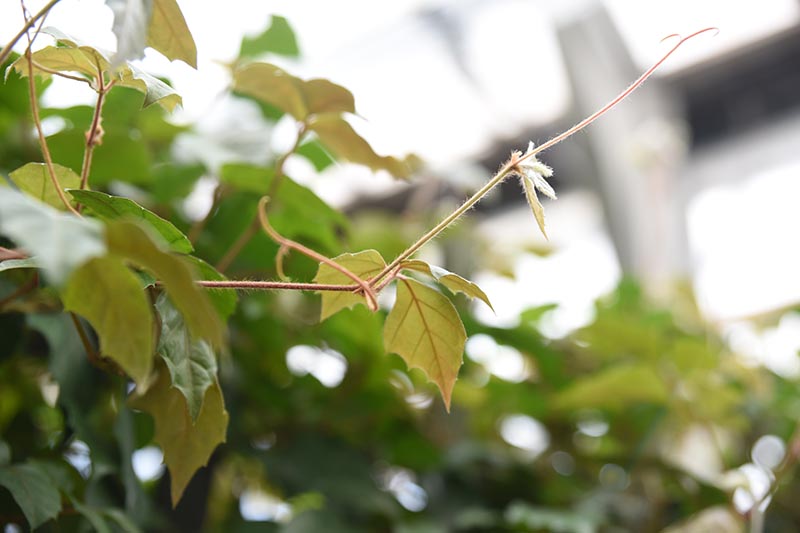
This plant prefers moderate, indirect light but it can tolerate low light. Once you’ve potted your grape ivy, place it in an area that receives four to six hours of indirect light if you can.
If you can’t achieve this, growth will be slowed, but it won’t mind otherwise.
Despite being native to the tropics, this houseplant does well in the humidity levels of the average home, somewhere between 30 and 60 percent.
In the winter, you may need to put a cool mist humidifier in the room to help keep the plant from drying out too much. An extra-dry plant invites spider mites, which a humidifier can help you to avoid.
A humidifier helps the rest of the family avoid dry skin, too, so that’s a bonus!
This one-gallon humidifier from Crane can add moisture to a 500-square-foot room. You can choose from one of four colors, available at the Home Depot.
When the plant is established – or in other words, when it begins to reliably grow new tendrils and leaves – you can slow down the watering schedule to about once a week.
Allow the top two inches of soil to dry out between watering, and you’ll have a happy plant.
Once a year in the springtime, fertilize your grape ivy with houseplant fertilizer according to package instructions.
This eight-ounce bottle of 1-1-1 NPK fertilizer from Miracle-Gro does the trick. It’s available for purchase at the Home Depot.
If you notice at some point during the growing season that the leaves aren’t as deep green as they should be, you can give your plant another dose of fertilizer.
Otherwise, hold off on the fertilizer, as this plant does not appreciate being overfed.
Growing Tips
- Water about once a week, allowing the top two inches of soil to dry out.
- Set up a humidifier in the wintertime to battle dry air
- Fertilize once every spring with a 1-1-1 NPK houseplant fertilizer.
Pruning and Maintenance
Some sources will tell you only to prune indoor grape ivy in the spring, but that doesn’t make a whole lot of sense.
The plant doesn’t react as much to the seasons outside when it’s growing indoors, as long as it’s provided with enough light and the temperature doesn’t fluctuate significantly.
According to experts at the Missouri Botanical Garden, you can prune grape ivy at any time of the year.
Pruning at least once or twice a year can shorten the ivy’s length or make it less bushy, to suit the size of the space and the style that you’re going for. It can also help to improve airflow, an important step in preventing disease.
To trim, use a pair of clean pruners and cut a vine just above a leaf node.
Before you toss the cuttings, why not propagate them instead and give the new starts to friends as gifts? Grape ivy is perfect for the beginning gardeners in your life!
Aside from pruning, you’ll probably need to repot your grape ivy once every two years or so. When the roots begin poking out of the drainage holes, or water stops draining quickly through the soil, it’s time to repot.
You’ll want to move your plant into a container that’s about two inches wider and deeper than the current pot. Make sure it has drainage holes and a detachable dish, too.
Fill the container with a quick-draining potting mix and make a hole inside that’s the depth and width of the root ball inside the current container. Follow the instructions outlined above for transplanting.
Until you notice that the plant is actively growing new vines and leaves, water every few days after repotting. Allow just the top inch of soil to dry out thereafter.
Species and Cultivars to Select
Despite once being a beloved houseplant, grape ivy can be hard to find. If you do track down a cultivar, any cultivar, you’ve basically stumbled upon a pot of gold!

Thankfully, the species plant is a little more common. You can purchase a live, four-inch grape ivy from The Plant Farm Store on Amazon.
You can also try searching your local online marketplace listings to see if anyone has a grape ivy for sale.
For best results in your search, try all of the potential names growers might know it by, including, grape ivy, grape leaf ivy, Venezuela treebine, C. alata, and C. rhombifolia.
I admit I might be a tad bit jealous if you find one of the rare cultivars, like ‘Ellen Danica.’ Back in the day, this was a very popular option.
Its leaves are large and deeply lobed, giving the plant a fancy, delicate look. Check local nurseries for this rare plant, and note that this variety can be susceptible to powdery mildew.
‘Mandiana’ is an ideal variety for those of you who prefer trellises over hanging baskets, as the vines are more upright than trailing. It’s also more disease-resistant than ‘Ellen Danica.’
The leaves are attractively shiny, and the plant holds up well even with frequent handling. If you have kids around, ‘Mandiana’ is the cultivar for you. Plus, it’s a fast-growing, easily propagated variety – you should be able to reliably root a new plant from a single cutting.
Slow-growing ‘Fionia’ is a cultivar that features wider leaves than many of the others. And the two small leaflets on either side of each central leaflet have shorter stems, giving ‘Fionia’ a more compact look.
Managing Pests and Disease
There are only a handful of pest and disease issues to keep an eye out for when you’re growing Venezuela treebine as a houseplant – yet another reason to bring it back into popularity, if you ask me!
If conditions are too dry, you may end up dealing with spider mites (Tetranychidae spp.). They’ll spin a fine web on your plant and suck sap from the vines and leaves.
But if you remove the webbing and any damaged leaves as soon as you notice the infestation and treat your grape ivy with miticide or insecticide right away, your plant shouldn’t suffer any lasting damage.
I use Bonide’s Mite-X because it’s an organic miticide that employs the power of cottonseed, garlic, and clove oil to treat mite infestations.
You can purchase it in a 12-ounce or quart-sized ready-to-use bottle from Arbico Organics.
Learn more about how to control spider mites in our guide.
Mealybugs (Pseudococcidae spp.) can pose a problem if your home is warm and your plant is overwatered, as they thrive in moist, warm conditions.
But these sap-sucking, soft-bodied insects also love warm, dry conditions, so make sure you check your grape ivy leaves every few days to make sure no white balls of “fluff” have appeared on the leaves.
If you do notice a mealybug infestation, take care of it right away by spraying neem oil on all plant surfaces. Remove the dead bugs by wiping them off with a clean rag after treatment and dispose of them.
When it comes to diseases, you’ll mainly need to watch out for fungal issues like powdery mildew, leaf spot, and stem rot.
Avoid overwatering and burying the stem, water only at the soil line, and prune your plant annually to promote airflow between the vines and leaves. Taking these simple steps can help you avoid significant problems.
To treat any fungal issues that do arise, remove affected leaves and spray the plant with a copper fungicide, like this one from Bonide, which is available in a 16-ounce ready-to-use bottle from Arbico Organics.
Best Uses for Grape Ivy
We’ve discussed hanging baskets and trellises already, but I would be remiss if I didn’t mention this idea offered up by the experts at the Missouri Botanical Garden: what if you grew several grape ivy plants to create an attractive room divider?
The Lechuza Trio Cottage Wicker Box from ePlanters is perfect for this.
Lechuza Trio Cottage Wicker Box
It comes in two sizes: 39 by 13 by 13 inches, or 51 by 17 by 17 inches. Each includes three self-watering planters with drainage holes, and the planters have handles, so they’re easy to remove from the decorative container.
To complete your grape ivy room divider, order the Lechuza Trio Trellis Attachment, also from ePlanters, which comes in two sizes that fit either the 39-inch or the 51-inch wicker box. Each comes with clips to help you guide the vines along the trellis.
Talk about a beautiful piece of “furniture” to show off to your friends!
You can also put your grape ivy in a regular pot and set it atop a bookshelf. The tendrils will trail over the sides of the container, making an elegant frame for your books.
Quick Reference Growing Guide
| Plant Type: | Woody evergreen vine | Foliage Color: | Green/dark green |
| Native to: | Tropics of North and South America | Maintenance: | Low |
| Hardiness (USDA Zone): | 10-12 (outdoors) | Tolerance: | Heavy shade |
| Bloom Time: | Spring-summer outdoors, rarely indoors | Soil Type: | Cactus mix |
| Exposure: | Indirect light | Soil pH: | 5.5-6.2 |
| Time to Maturity: | 3-5 years | Soil Drainage: | Well-draining |
| Planting Depth: | Depth of the root ball | Companion Planting: | Peace lily, fiddle-leaf fig, Swiss cheese plant |
| Height: | 2-10 feet | Uses: | Houseplant |
| Spread: | 1-6 feet | Family: | Vitaceae |
| Water Needs: | Moderate | Genus: | Cissus |
| Common Pests and Disease: | Aphids, gnats, mealybugs, spider mites; leaf spot, powdery mildew, stem rot | Species: | Alata (syn. rhombifolia) |
Bring the Tropics Indoors
No matter where you live, you can enjoy your own slice of paradise inside when you grow a grape ivy plant.
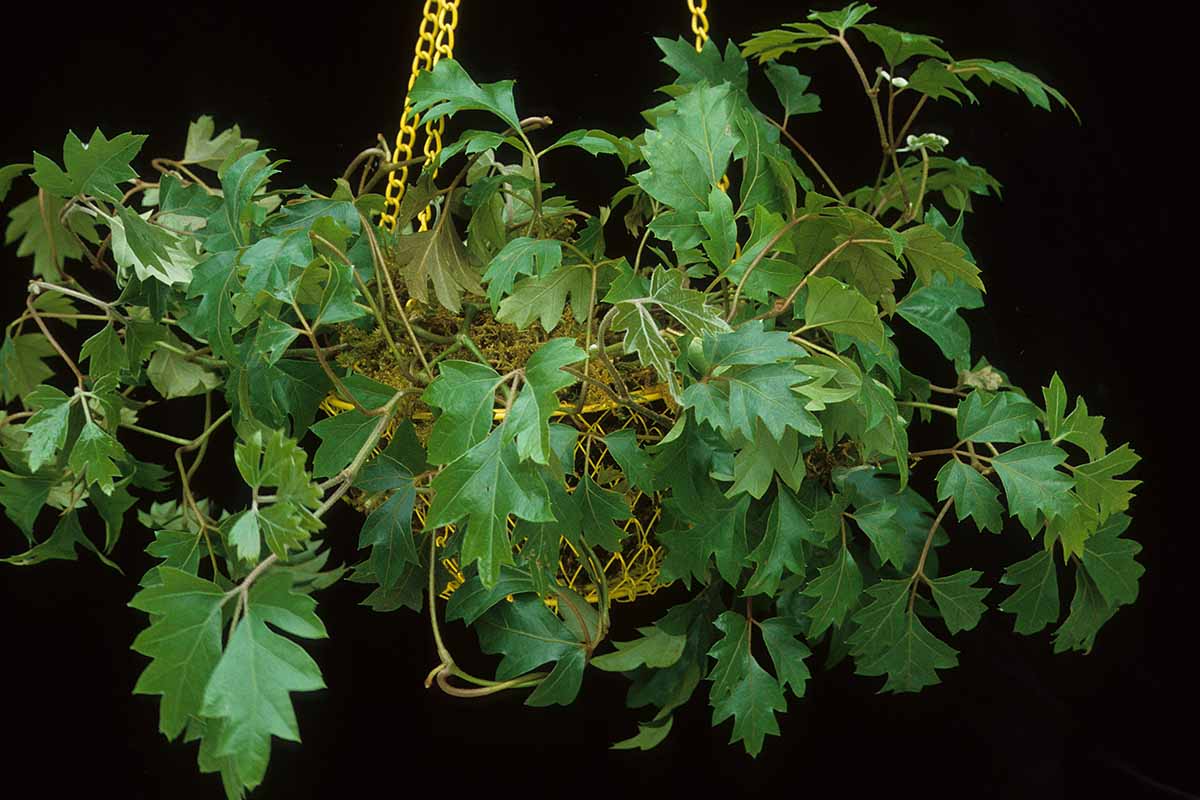
Have you ever grown and cared for one of these as a houseplant before? Do you have one in your home that’s been alive for years and years? I’d love to hear your stories and questions in the comments section below!
And before you go, check out these guides to growing graceful houseplants next:
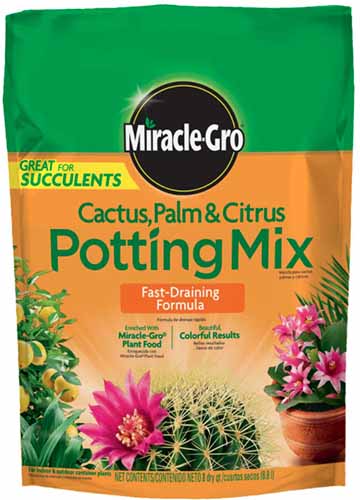
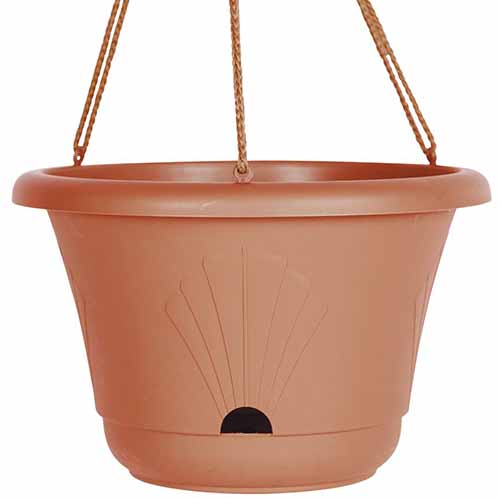
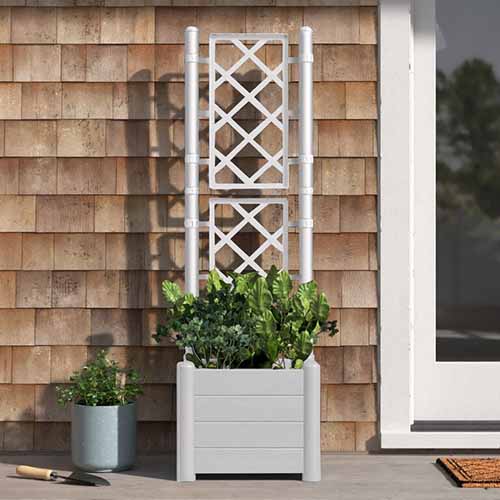
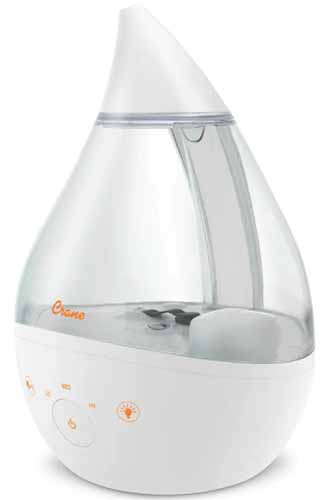

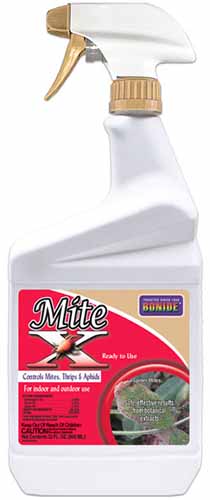
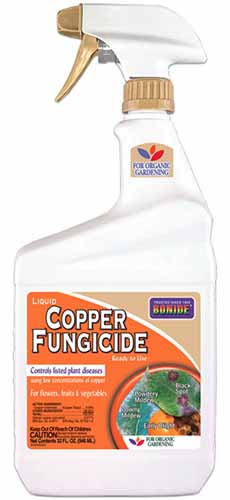
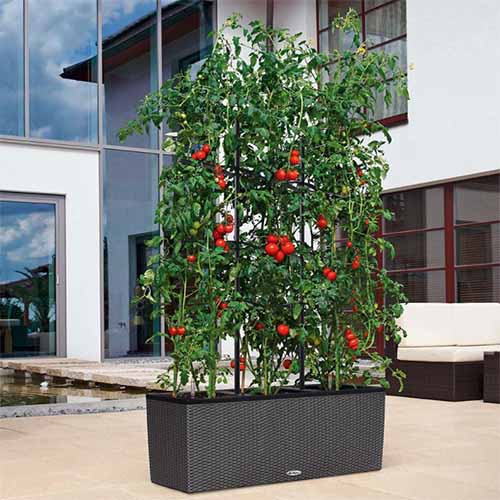
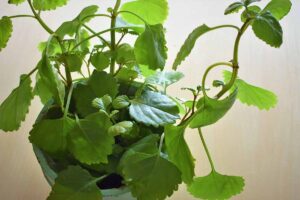

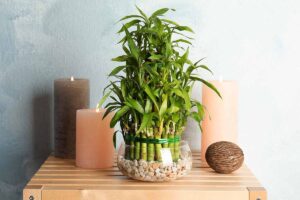
I have a grape ivy that was my aunt’s. She passed away when I was 4, I’m almost 36. I know she had it for years before she passed.
How wonderful to be able to continue caring for this plant in her memory! Thanks for sharing, and happy gardening!
I have had my grape leaf ivy for over 40 years. At one time the branches hung down kind of trailing. It seems to have evolved over the years becoming more upright. One branch has crossed over to the opposite side and hangs down. I’d like to prune that but don’t know at what angle to cut the branch so it will grow out on the side of the plant it is on. Please advise!
My grape ivy is a cutting taken from a plant my mum owned many years ago. It is easily 15 years old and has moved house with us many times. It has been cut back several times as it is enormous but recently it has suffered from mildew and I’ve had to reduce its size drastically to remove the affected leaves. It’s a family member and I’m worried about it as I’d hate to lose it!
Hi Pat, how wonderful that you have kept your plant thriving for so long! Provided you didn’t remove more than one third of the foliage, your plant should be all right.
Thanks for all your great info! I have an old grape ivy which I am propagating cuttings in water. I haven’t done this in a long time and I want to know if this is normal…see attached images of roots!
Hi there barbara. That’s pretty impressive and I love to hear that you have an old grape ivy that’s still hanging in there. I am fairly certain those odd growths are just the calluses that form at the bottom of the cuttings ahead of them sprouting roots. If they start smelling bad or those white portions are mushy, you might want to start over, but I feel like you’re fine here. Also, make sure you’re changing the water every couple of days. It looks clear here, so that may be a reminder you don’t need. Good luck, and kindly let… Read more »
I have a grape ivy that I repotted a few years ago and it is doing well, except that is is now sending out lots of long tendrils, with barely any signs of sprouting new leaves. Shold I cut them, or just let then go.
Hello Annette.
I’m glad to hear your re-potted plant is mostly doing well. I think you’re probably okay to leave the tendrils if you like how they look, or don’t mind how they look.
As for the lack of leaves, you may want to try to fertilize a bit starting in the spring. And it might be fun to take a cutting or two and start a new plant, too. Good luck, and thanks for reading.